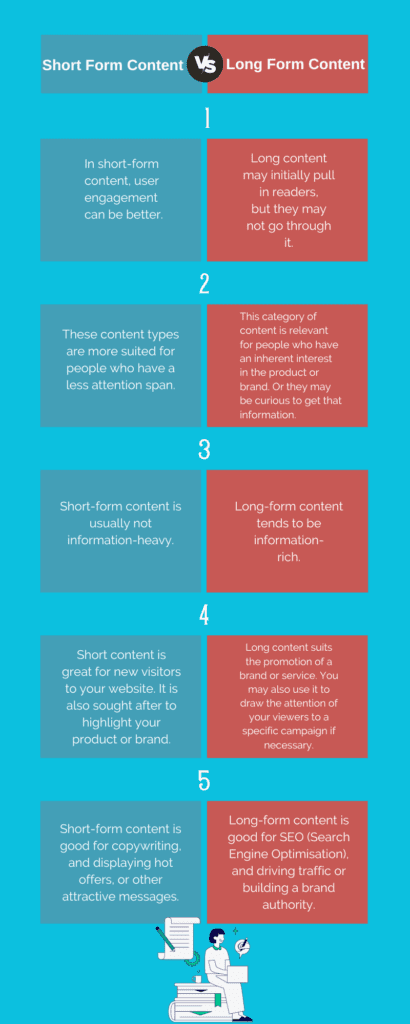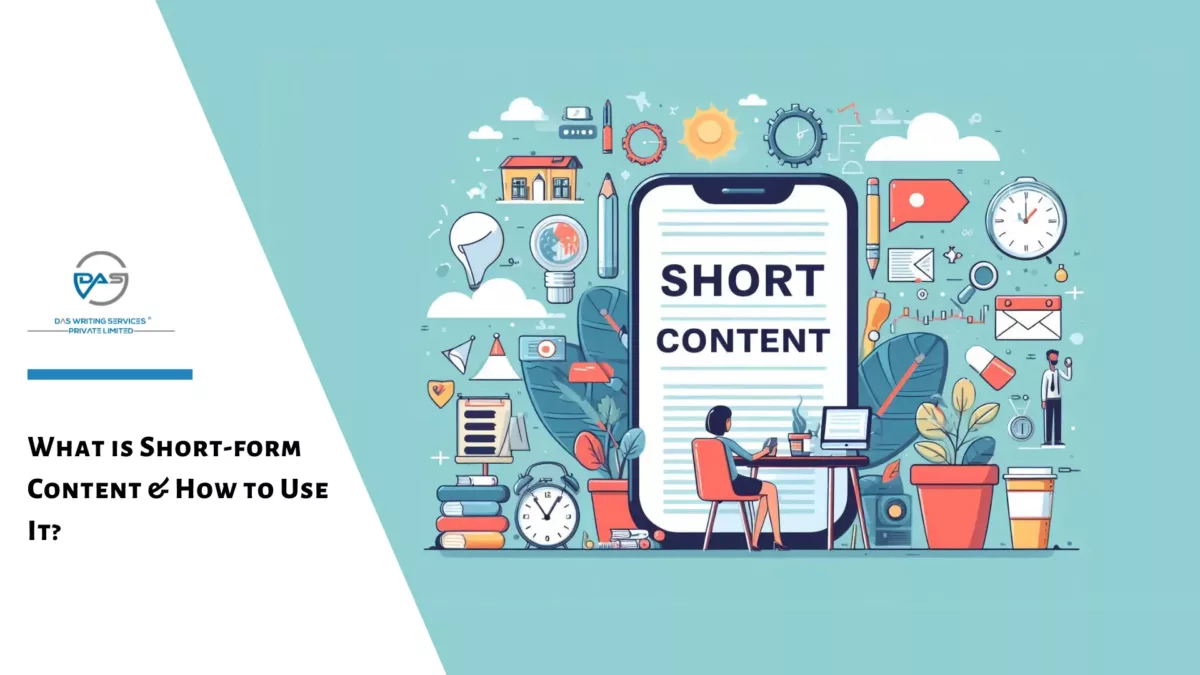Content has a crucial role in terms of bringing engagement to a business. However, what confuses the writers and marketers, is how to know the ideal content length for a topic. You have to understand a lot of factors before you can decide on the content length.
Some topics or scenarios in a business may need long-form content, while others require short-form content. Depending on the project and its necessities it will be crucial to understand the type of content that fits the purpose. You may consider short and value-enriched content and its impact in drawing customers.
So without further ado, let us start understanding the differences and some related information to understand the value of concise content and its importance.
Want to avail engaging short form content for your business? Reach out to us
What is Short-Form Content?
It is a piece of content that your audience can grasp and understand quickly. Typically such content offers an overview of the topic. It may not necessarily be a blog or a written article, but could also be an youtube short or a tiktok video. The core function of this content is to convey the basic idea to the audience, briefly and easily.
The length of content which you mark as short or long, depends on the topic itself. Generally, short blog posts range between 700 to no more than 1500 words. In digital marketing, short form content or micro content tends to receive higher engagements.
On the other hand, long-form content is any content that is extensive and deals with anything deeply. The time for grasping and understanding such kind of content is usually higher. If a viewer has more time on their hands, then it is obvious they will be attracted to a longer content format.
Moreover, the length of content is highly variable and it depends on some important factors. These factors may include the target audience, products or services offered, or it can be simply framing words until they seem like helping you achieve goals.
Short Form Content vs. Long Form Content
In our quest to understand the short vs. long-form content, we will try to simplify things better for you. Take a glance at the image below to understand the difference between long and short content.

With that being said, it is best to use a mixture of long-form and short-form content as per your requirements. If you are a new brand that needs to highlight your products to your audience, long-form content may be a requirement.
On the other hand, if you are an established brand, you may choose to incorporate short-form content in copywriting style to build more engagement. Additionally, the shorter content length is easily digestible for a reader and they remember it easily. You need to realise that your readers are humans as well, with a low attention span, now this is a common thing to keep in mind!
What are the Benefits of Short Form Content?
Well, you may ask how short-form content affects the brain, the answer to this is mostly positive. There are a few benefits of short-form content on our brains. Some of these advantages are as follows:
1. Quick Engagement on a Wide Variety of Topics
A short form of content is essential for capturing attention swiftly and providing information quickly. Due to the low time taken to comprehend the topic, this is a good strategy if you focus on multiple topics at once. Focus on short-form content creation if your audience has a limited attention span.
2. Faster and Efficient Learning
As the content length is comparatively short, it helps in quick information retrieval and easier learning. Moreover, with short content, you can post it anywhere and increase the reach of your message effectively.
However, keep a note due to the condensed nature of information, the full picture of a topic may not be revealed. Try to substitute that by writing additional short posts on the same topic covering multiple dimensions.
3. Less Research Time
Long-format blogs or content needs extensive and comprehensive research, for generating it. In comparison, the short-form content does not have a lot of research time and it is comparatively easier to write. If you are using the content for marketing purposes, you need to make sure that the quality of the content is higher to increase conversion and traffic.
4. Immediate Call to Action
To understand this, consider an example where you order food from brands like Zomato. The company has your number or an email ID with them. Now you will often receive mail about their offers in a creative way like “Bhel Delivered Faster than a Bail”. This type of short-form content is appealing to readers and encourages them to make purchasing decisions.
5. Increasing Demand
Between short-form and long-form content, there has been a noticable increase in the demand of shorter bite sized content pieces. Reason why tiktok, reels and youtube shorts are on the rise and the industry is expected to grow at 10.2% CAGR by 2030. If you notice, Google too has lately been highlighting shorter content posted on platforms like LinkedIn and Medium.
What are the Best Practices for Creating Short-Form Content?
While short content creation may seem pretty straightforward, it needs a lot of prior research. If the content does not align with your audience well, it can do more harm than good. Some of the best practices to create short content are as follows:
1. Pay Attention to New Trends
If you are attempting to leverage short-form content, it is important to understand the market trends. And the video platforms are the place to start to find out what is up and trending in your industry. By comprehending the requirements of your target audience, developing concise content that suits your needs becomes easier.
2. Understand the Value That You Highlight
Short written content can be a great addition to your content marketing strategy, as it allows you to leverage in informing, entertaining, or educating your audience. If the content is humorous, it can provide entertainment value. Comparatively, if you are trying to create knowledge then a long-form video could be a more appropriate bet.
You may also use concise content to educate your audience about a concept or product that you have launched.
3. Hook Your Audience
Understand your audience’s motivations and interests before creating any content. Try to grab your reader’s attention by introducing a hook in the first paragraph, ideally getting straight to the point.
It is recommended to keep your content concise by creating short-form content that still manages to introduce the hook at the perfect spot. Additionally, using current events to create content can help make it more relatable and engaging for your audience, especially if you can provide context.
If you ask which one is better between long-form and short-form content, the answer is not that straight. While some of the purposes of marketing strategies require a longer content strategy others need a shorter content strategy. Always try to balance your content length by taking into consideration the required marketing strategy.
Now that you have understood the basics of short content let us understand how to create one.
How to Create Short-Form Content?
Creating concise content is an art and the way you can leverage that depends on the platform where you post it or the type of content that you are planning to create. Some of the common short-form content and their writing strategies are as follows:
1. Blog Posts
Generally, if you are trying to create a short-form blog post the length should be less than or equal to 1000 words. Although the blogs are shorter, that necessarily does not mean that you do not add any value. Try to inform, educate, or attract your audience with the blog that you have written.
Get to the point of the blog post quickly and avoid just throwing information everywhere. Incorporate a perfect ratio of information to engagement (Information: Engagement) in your blog post. If you need high-quality blog writing services then consider the experts in the field!
Understanding the ideal (Information: Engagement) ratio is the perfect way to boost engagement with micro-content on social media or any other platform. If necessary try to introduce some examples in between the blog content to show the audience its relevance.
2. Social Media Posts
Some platforms have word limits which essentially reduce the length of the social media content. However, that does not mean that social media posts need to be unappetising. Include photos or memes, and use them as a part of your marketing strategy to drive profits.
Social media platforms are regularly used by people, making them one of the best places to experiment with types of short-form content. Create catchy taglines, that drive more engagement and help you reach the ultimate goal of marketing.
A study by Gitnux shows that 91% of businesses use two or more social media channels for marketing purposes. They have also found out that social media posts have a 100% lead-to-close rate than outbound marketing tactics. Such data concludes that social media posts are powerful if your short-form content has that hook in it.
3. Short Videos or Reels
It is not a surprise anymore that people nowadays invest a lot of time watching reels and scrolling through their feeds. The rise of contextually relevant short-form video content has emerged as a powerful tool for content marketers. Thanks to the creativity of human minds, they are engaging and easily drive traffic.
Short-form vs Long-form Content: Which is Better for SEO?
This is a common question that plagues new content creators in the industry. Short-from or long-form content, which is better for SEO? Although both have their share of pros and cons, the ultimate answer is completely dependant on your industry.
Mostly, B2C industries use short-form content to engage and inform. That being said, not all B2C businesses can produce effective results on the SERP with micro content. It ultimately boils down to the marketing strategy,
You can determine your digital marketing strategy by keeping the following factors in mind:
1. Target Group of your Business:
Gen Z and the Gen Alpha are the primary target group for short-form video content. On the other hand, short blog content tends to perform better for the older age groups like milennials who are more used to consuming written content.
2. Category of Product and Services:
When you are dealing with specialised industries, long-form content is typically the better alternative. For instance, quantum computing and block chain technology both are fairly new and niche areas where one must create proper knowledge first. Hence, bite-sized content may not be the best strategy for consumers.
3. Agenda of Content Production:
While some create content to enhance brand impression, others use content to nurture leads and convert the audience. So, while short-form blogs and videos may be better for popularising your brand, longer form of content can help you nurture the users for better reception.
When it comes to SEO and rankings, there is no defining line between short or long form content. If your short video or blog can offer a basic overview of the topic, it will get the attention. Similarly if you are able to cover all the nuances of the topic in your long-form video, it will get the desired attention. Ultimately, it boils down to the content’s ability to cater to the user’s queries and concerns that produce higher ranks and better engagements.
Steps to Create Effective Short-form Content
You can follow the below mentioned strategies to create engaging short form content to promote your business online:
A. Keyword Research
Firstly, try to do your keyword research properly, and identify the relevant keywords for your content. Follow these steps to gather accurate keywords for your content:
- Open any keyword explorer tools available online.
- Try to find relevant keywords that have a convenient keyword difficulty and a high search volume.
- Now using the keywords, identify the top-ranking blogs or other content in the Google SERP or your target search engine.
- Check the content for its length, use this to get an idea of the average length of content that you have to produce.
Secondly, try to conduct a detailed analysis of your content subheads by understanding your competitors. Identify the key trends that you find in their long-form and short-form content. Add a twist of your own by diving into in-depth research by finalising the headings and subheadings.
B. Planning Content Type
You also need to plan about the type of content that you are focusing on. Some of the popular content types that you can find in various search engines are as follows:
- Guides
- How-to
- Reviews
- Definitions or informative content
- Comparison posts (vs. posts)
After performing all these steps, this is the perfect time to understand the content length you can write.
Takeaway
Content has a lot of flexibility, and you can tweak it anyway to achieve what you need. If you think that you need short-form content try to gather a better understanding of how it will affect your marketing strategy. Understand the market trends and tweak your content accordingly for increased relevance.
If needed you may also look at ideas to improve content marketing ROI, by focusing on a concise content strategy. Additionally, try to get a thorough understanding of the topic, and do not write extra using fluff content.
Address what a user seeks Head-ON!
Frequently Asked Questions
1. What is short-from content on Google?
Generally, any content lesser than 1200 words is considered a short form content.
2. Is short-form content good?
Short-form content is a type of video or text content which a user can consume easily and quickly to get the overview of a topic.
3. What content is good for SEO?
Blog posts typically perform well on the search engines. They also tend to be shorter and are usually wrapped up within 1500 words.
4. Who needs short-form content?
Short form content are more appropriate for people looking for quick answers to the problems without venturing too deep into the topic.
5. Is short form content profitable?
Short form content have a higher tendency to be viral and are able to attract and engage a large number of users across the internet.

Ritish Dutta is a seasoned Content Developer with over 7 years of experience in the industry. Currently, at Das Writing Services, he writes SEO-optimized content that caters to our diverse clientele. Ritish utilizes his critical insights and experience to talk about digital marketing, SEO content writing, content strategy, and AI.





Leave a comment
All comments
Arghish Das
This is a really helpful article! I like the idea of using different types of content to reach more people. I'm wondering how you choose the right format for each topic. Is there a specific way to decide if a short or long-form post is better? Thanks for sharing your knowledge!